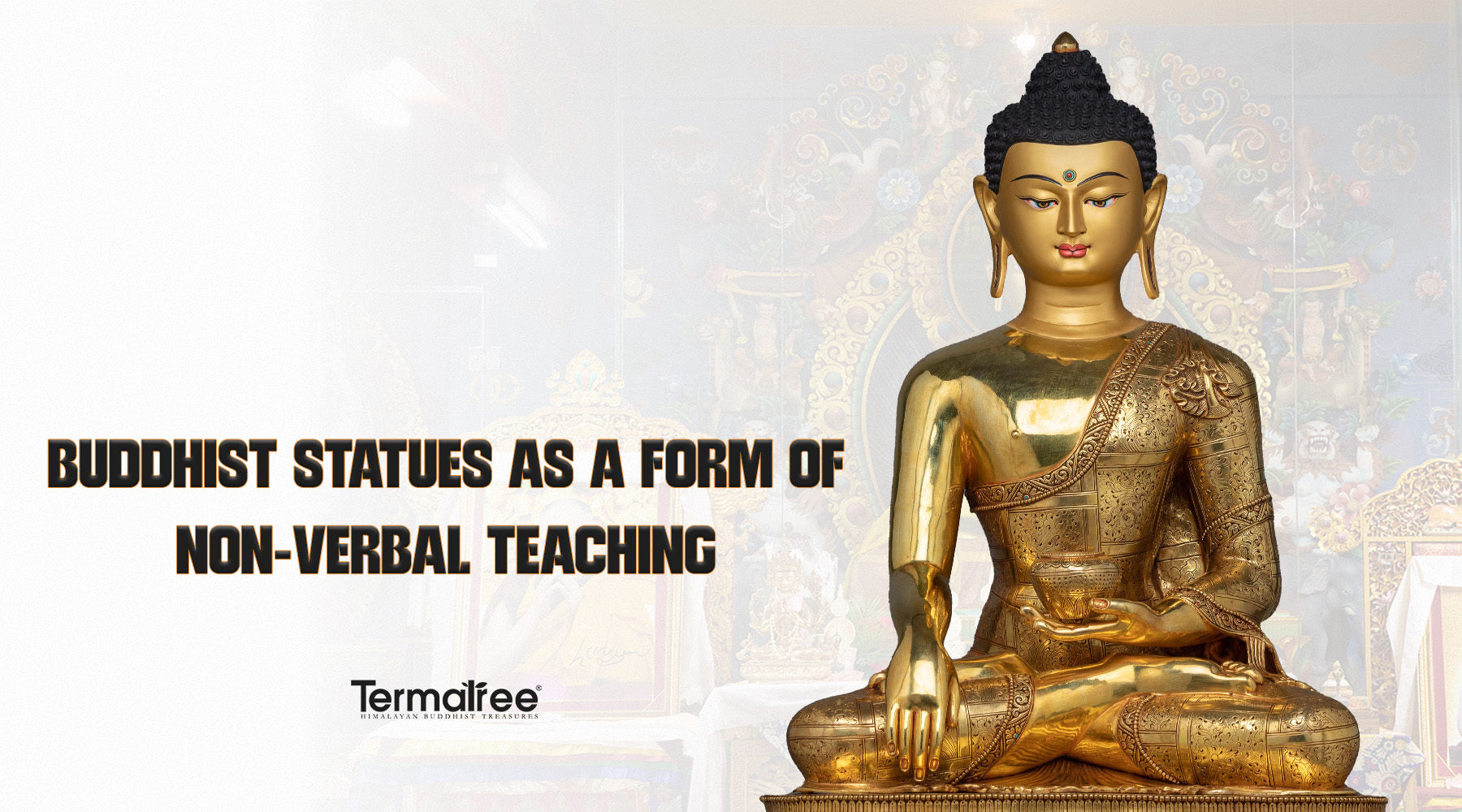Buddhist Statues as a Form of Non-Verbal Teaching
In the rich tapestry of Buddhist practice, statues are not merely decorative elements but profound tools for teaching and spiritual guidance. Particularly in Vajrayana Buddhism, these statues transcend their physical form to become a conduit for conveying deep spiritual truths and practices.
Key Takeaways:
- Buddhist statues are more than artistic representations; they are a form of non-verbal teaching.
- In Vajrayana Buddhism, statues are crucial in meditation and spiritual practices. These statues carry deep symbolic meanings, representing various aspects of enlightenment and Buddhist teachings.
- They serve as a focus for meditation and a means to transmit teachings beyond words.
- The impact of these statutes on practitioners is profound, offering psychological and spiritual benefits.
The Role of Statues in Buddhism
| Historical Context | Period |
| Development in Buddhist Statuary |
1st-2nd Century CE |
|
Emergence of anthropomorphic Buddha statues in Gandhara and Mathura |
5th Century CE |
|
Spread of Buddhist art along the Silk Road |
6th-8th Century CE
|
Development of distinct regional styles in Asia
Since the early ages of the faith, Buddhist statues have played a significant role in both Buddhist art and practice. At first, the Buddha was symbolized by images like a footprint, the Dharma wheel, or a Bodhi tree. But throughout time, anthropomorphic depictions proliferated, with each region establishing its own distinctive style.
Exploring the Essence of Buddhist Statues

Click here to view our collection of Maitreya Buddha Statues
- Role of Statues in Buddhism
Buddhist statues play a pivotal role in shaping the essence of Buddhism. Beyond decorative elements, they serve as powerful catalysts for introspection and prayer, inspiring those who engage with them. Embracing a Buddha statue as part of your home decor enhances aesthetics and fosters a tranquil atmosphere, tapping into the profound connection between Buddha and serenity.
- Meaning and Symbolism
Within Buddhist statues, figures such as Buddhas, Bodhisattvas, and other deities emerge, embodying intricate positions or mudras laden with symbolism and profound significance. Familiarizing yourself with these nuances empowers you to choose a statue that resonates with you personally, deepening your understanding and admiration for the artistry involved. Buddha sculptures are believed to infuse positivity and tranquility into your surroundings, offering a continuous source of uplifting energy throughout your day.
Statues in Vajrayana Buddhism

Click here to view our Namtoshe Gold Statue
- Iconography and Symbolism
In Vajrayana Buddhism, statues often depict the historical Buddha and a variety of Bodhisattvas, deities, and Dakinis (female embodiments of enlightenment). These figures are rich in symbolic elements, each conveying specific teachings or aspects of the spiritual path.
| Deity | Symbolism |
| Avalokiteshvara | Compassion |
| Manjushri | Wisdom |
| Tara |
Protection and Healing |
The Use of Statues in Practice
In Vajrayana practice, statues are often used in tantric rituals and meditation practices. Practitioners visualize themselves as the deity, embodying its qualities, a powerful method for transforming the mind and cultivating qualities like compassion and wisdom.
The Educational Aspect of Buddhist Statues
- Non-verbal Transmission of Teachings
Buddhist statues are a form of Dharma teaching that transcends language. They communicate profound spiritual truths directly and experientially, often making a deeper impression than verbal teachings.
- Statues as a Focus for Meditation
Statues serve as an essential focus in meditation, helping practitioners visualize the qualities of the Buddha or deity and internalize them. This practice is particularly emphasized in Vajrayana Buddhism, where visualization is vital to the path.
- Mudras and Postures
Buddhist statues frequently show the Buddha in various stances and mudras, or hand motions, each with a unique symbolic meaning. It is like reading a visual language to comprehend these motions since each mudra represents a different facet of the Buddha's teachings. For instance, the Abhaya Mudra, representing fearlessness, inspires practitioners to develop bravery as a virtue along their spiritual journey.
- Iconography and Stories
The physical presence of Buddhist statues in meditation areas and temples fosters a spiritual practice-friendly atmosphere. These statues inspire inspiration and a sense of calmness with their calm looks and sympathetic faces. These sculptures provide a silent companionship that comforts practitioners and creates an atmosphere ideal for meditation and contemplation.
Impact on Practitioners
- Personal and Community Benefits
Buddhist statues serve not only individual practitioners but also the wider community. They act as reminders of the Buddha's teachings and inspire a sense of reverence and spiritual aspiration.
- Psychological and Spiritual Effects
The presence of Buddhist statues can have a calming and uplifting effect on the mind. They create a sacred space that facilitates a deeper connection to the spiritual path and supports mental and emotional well-being.
- Inspirational Presence
Buddhist statues physically present in temples and meditation areas foster a spiritual practice-friendly atmosphere. These statues provide inspiration and relaxation with their calm looks and kind faces. The silent companionship of these statues often provides practitioners with comfort and a favorable environment for meditation and contemplation.
- Meditation Aid
Buddhist statues help practitioners focus and be mindful during meditation by acting as focal points. People can learn to anchor their thoughts and develop an inner sense of quiet by looking at a statue. Meditating with meditation can strengthen a practitioner's connection to the spiritual lessons reflected by the sculptures.
- Educational Pilgrimages
Travelers who visit locations with important Buddhist sculptures can have a distinctive educational experience. Experiencing locations embellished with colossal statues offers a palpable link to Buddhism's rich cultural legacy and history. Rituals, lessons by resident monks, and a deeper comprehension of the Dharma are all everyday activities for pilgrims.
Buddhist statues, particularly in Vajrayana practice, are influential non-verbal teachers. They convey profound spiritual truths, aid in meditation, and profoundly impact individual practitioners and the Buddhist community. These statues are not just art; they are embodiments of the Dharma, guiding followers on the path to enlightenment.




